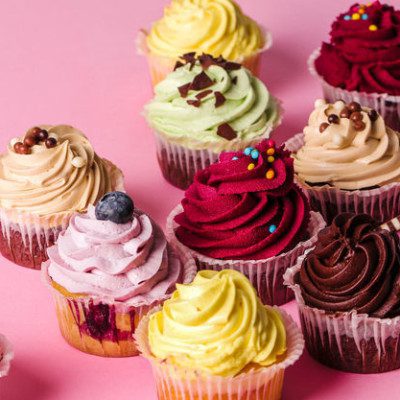How are cupcakes made?
Following is a typical cupcake formula that uses multi-stage mixing method:
| Ingredient | Baker’s % |
| 1st stage | |
| Chlorinated soft wheat flour (air classified, short patent) | 100.0 |
| Sugar (refined, granulated sucrose) | 110.0 |
| All-purpose shortening | 37.0 |
| Emulsifier | 1.0 |
| Salt | 2.5 |
| Baking powder | 5.0 |
| Non-fat dry milk | 9.0 |
| Liquid whole eggs | 54.0 |
| Water | 9.0 |
| 2nd stage | |
| Water | 34.0 |
| 3rd stage | |
| Water | 30.0 |
| Vanilla | 1.5 |
Commercial production of cupcakes:
- Ingredient scaling/metering
- Mixing (until a target specific gravity is reached)
- Depositing
- Baking
- Cooling
- Finishing (icing)
- Packaging or displaying
Mixing specifications:
- Add all dry ingredients, including fat, in the mixing bowl and mix at low speed for 1 minute, while slowly adding the liquids from the first stage.
- Scrape down bowl and mix for 4 minutes.
- Mix for another 1 minute while adding the water from the second stage.
- Scrape down bowl and mix for another 2–4 minutes at low speed until the required target specific gravity is reached (0.85–0.875).
- Mix for another 1 minute on low speed while adding the water and vanilla from the third stage.
- Scrape down the bowl and continue mixing for about another 4 minutes on low speed.
- The batter can then be deposited into pans/moulds and baked as required.
While the above formula describes a recipe for the production of cupcakes using the multi-stage mixing method, commercial-scale production may use different formulations if a continuous mixer is being used.
Important guidelines for producing cupcakes
- Batter viscosity is important to cupcake production as it will directly affect its baking performance and final appearance. A fluid batter would cause the product to have a flatter top, while a viscous batter would have greater tolerance and result in a rounder top. Extremely thick and highly viscous batters result in cracked peaks and underbaked cakes.
- Due to their small size, cupcakes require shorter bake time and lower temperatures than regular size layer cakes.
- Higher temperatures may cause the outside to set too quickly, leaving the inside under baked, or may result in cracks and leaks forming on the surface.
- Lower temperatures may result in flat top cakes. It is important to balance baking time and temperature to create the characteristic domed top associated with cupcakes.
- The ratio of batter to pan size also plays an important role in determining the appearance of the product. Using a higher ratio can result in larger size cupcakes
- The cupcakes are often filled and/or glazed after baking and cooling to increase variety in the product.
Large-scale bakeries using continuous mixing may need to introduce formula modifications such as substituting butter/shortening and eggs with emulsifiers/butter flavorings and egg replacers, respectively to help manage cost.
References
- “Cupcake | Definition of Cupcake in English by Oxford Dictionaries.” Oxford Dictionaries, https://en.oxforddictionaries.com/definition/cupcake, Accessed 14 Jan 2019.
- Leslie, E.. “Cakes – Ginger Cup Cake”. Seventy-Five Receipts for Pastry, Cakes, and Sweetmeats, 9th edition, Boston: Munroe and Francis, 1836, pp. 63.
- Simmons, A. “A light cake to bake in small cups”. American Cookery. Facsim. Ed., 1796, pp. 48.

